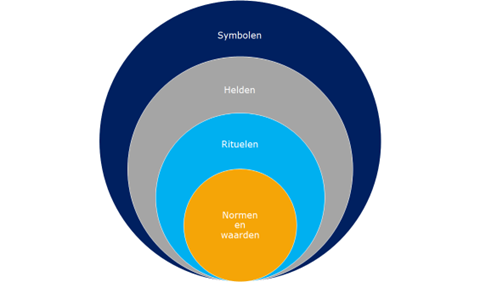In our consulting practice, we are working daily to help organizations become more data-driven. Not because it has to, but because it creates value, for now and for the longer term.
In previous articles, we have emphasized that the road to data-driven work has many aspects. From people to data quality and infrastructure. In the many conversations and sessions surrounding the topic of data strategy and data-driven work, one aspect often emerges that is seen as crucial: culture.
Although crucial also the least tangible. Because what is culture? What does that mean in light of data? And how do you give hands and feet to moving toward a culture that makes data-driven work a success. Is culture the true key to success?
In this article, we give culture a place in the growth path to data-driven work, delineate it and provide concrete examples and steps you can take with your organization.
Why go data-driven and what does that require of an organization?
Data-driven work is popular but also open to many interpretations. At its most extreme, you could say it is the counterpart of “we just do whatever” as a guide to running your organization or department. Data-driven work breaks that. The popularity arises because a lot of boards, managers and employees feel that they are sitting on a mountain of gold. Dates.
With everything we now capture and know, especially through digitization, about customers, markets, processes and organizational performance, we are able to make better decisions. Make decisions based on insight, explanations, predictions and apply them in daily operations. In order to achieve the goals of the organization. Goals of (financial) performance, more satisfied and loyal customers, sustainability or the responsible use of community money.
Data-driven work an sich is thus not a goal but a way to create more and long-term value for your company and for your customers.
The shift to data-driven work requires more than just having data or having people who can do analysis. As also described in an earlier article, it means mastering the entire data value chain. From capturing, analyzing, interpreting to applying and cashing in. And setting up data management processes so that data is reliable and secure and can flow through the organization.
In addition to people, processes and resources, this also requires organizations to have the right structure and culture in place to make the change work. And apply data at a strategic level.
In the growth model we developed for data-driven work, you can see the connection of all these elements and the importance of developing them in balance.
Culture is perhaps the least tangible factor. And the least easily adaptable. But it is also the factor that has the most long-lasting effect in change.
Without the right culture, data becomes something that “has to” or an item on a checklist to check off. Without the intrinsic drive to make decisions based on insight, knowledge is never really developed and secured or applied adequately.
To determine what culture means in growing into a data-driven organization, we first zoom in on what culture is and what data-driven means in that light.
What is culture anyway?
And what does that look like for a data-driven organization?
If you ask people what the culture of their organization is, you usually get very different answers. From Friday afternoon drinks, whether or not to go to work in shorts and sandals, how approachable a board of directors is to how they are managed and judged.
If we look at the literature on what constitutes an organizational culture you also come across different definitions. Borsboom and Parlevliet created a nice overview of the corresponding characteristics in the most commonly used definitions:
- Culture is something shared by people
- Culture is carried by people
- Culture is learned
- Culture is not immediately visible and cannot be directly influenced
- Culture has an enduring, stable characte
These shared characteristics support the picture outlined that culture is broad and less tangible . It also already provides the first direction for change by weighting the “human” side in all definitions. And that change will be sustainable.
Further peeling off the concept helps to find more starting points for shaping culture change.
Elements of culture are aptly represented in Sanders and Neuijen’s UI model, in order of the layers of the onion. The deeper the layer the harder it is to change.
- Symbols
- Heroes
- Rituals
- Values and norms

To translate what role culture plays in the movement toward data-centricity, it is interesting to look at what the characteristics or elements of culture are and what they look like for an organization that is already very advanced in that area. In order to derive concrete actions needed to move toward a data-driven culture. A company with high data maturity might look like this on the elements of culture:
|
Symbols |
|
|
Heroes |
|
|
Rituelen |
|
|
Values and norms |
|
If you want to move toward this situation, it is good to make the distinction between mechanisms that directly and indirectly affect culture.
Direct mechanisms are things like:
- Data as a key focus for board and management.
- The demonstrable conduct and exemplary behavior herein by these layers.
- Include working with data in indicators, targets and assessment of employees.
- Include data-drivenness as a competency and belief in recruitment and selection of new employees.
- Mechanisms that have indirect influence are more related to other organizational aspects such as organizational structure, processes and procedures, communication and active propagation of data projects and results.
The understanding of what culture entails, what this looks like for a data-driven organization and what influencing mechanisms are, together with our broad experience from practice, leads to the top tips for culture change to a more data-driven organization, we do this in three steps.
Towards a more data-driven culture in three steps
Getting started with data and the culture aspects has roughly three steps:
Step 1 Why and how – when people really understand why we want it…they are going to want it themselves
- Formulate a clear vision of the role of data and its concrete goals – why are we doing it? What purposes does it serve? How does data help fulfill these goals. To this end, we developed the Target to Data model that helps elaborate on this step and visualize data and goals in context.
- Outline the how – create a cohesive roadmap that takes the organization and its employees through the steps being taken and who plays what role in them. In it, also work out the various cultural aspects, from symbols to values and norms that play a role
Step 2 Doing and learning – Creating heroes and myths – No better motivation than successes
- Create growth centers bottom up – Heroes and stories. Instead of organizing very large, it is often better to work with small multidisciplinary groups around some concrete use case.
- Doing by learning together with a focus on the here and now – Earning while learning. Select those use cases that serve an identifiable purpose and are feasible in the short term.
- Make this too measurable and communicate successes…and repeat…and repeat
Step 3 Structural anchoring
With a clear goal and first success stories, the structural anchoring and change will be initiated step by step (in accordance with the roadmap) with the following actions:
- Executive board and management as structural bearers and role models
- Embedding data in structure, processes and procedures of decision making
- Give data and its application a place in goals, management of them and assessment of employees
- Include data competencies and the values and norms you envision for them in the recruitment and selection of new employees
- Train and educate existing employees
Coherence and balance with other aspects – turning one knob does not work
Working toward a data-driven culture is not turning one knob. Anyway, because culture itself consists of many aspects. In addition, because the indirect mechanisms for culture change in particular also affect precisely the other organizational aspects assumed to be in balance in our growth model.
Only if you as an organization develop the aspects of people, organization, process and resources in cohesion and balance will it lead to the desired effect. Having a high-tech data environment or the best data scientist in house cannot alone make the difference.
Precisely also if the rest of the organization has the will, behavior, values and mindset to grow it is going to work. So yes culture is crucial, but not isolated. And best addressed by the combination of a clear how and what, concrete successes and heroes and the step-by-step structural embedding of data into structure, process and people side of the organization.
Want a first impression on how your organization’s data-driven culture scores against your ambitions and the other organizational aspects? Then do the scan for data-driven work.
>> Do the scan for insight into data drivenness
Want to learn more about how your organization can become more data-driven? If so, please contact us. We are happy to engage with you.
Would you also like to share with fellow managers and directors experiences on data-driven working, data strategy and crucial role of culture? Cmotions organizes and facilitates a relaxed and inspiring setting during a roundtable session. Read more about our upcoming roundtable session here.




